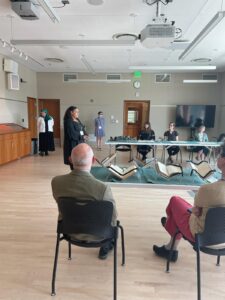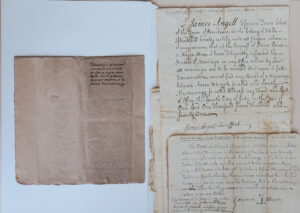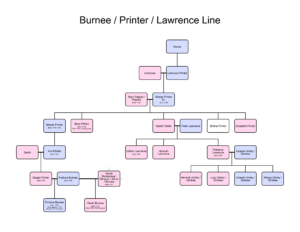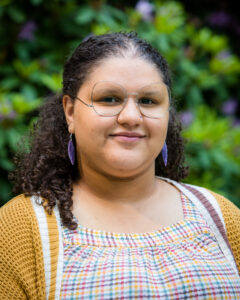As I near the end of my second summer at the American Antiquarian Society as an intern through the Library Internship for Nipmuc Community Members, supported by a grant from the United Way Central MA, I wanted to reflect on what this internship has done for me, and what I have been doing for it in return.

This internship has given me a passion for archives and librarianship – things I didn’t think I’d be interested in when I applied, as I’d mainly applied due to my love of books and history. I remember when I wrapped up my time at AAS last year, I was in disbelief at just how much I loved my time here and how much excitement for my future and career I came away with. It’s given me opportunities by way of admission to Simmons University for a library science degree and has given me hope for a future where I can steward cultural archives and give other youth from underprivileged communities the same opportunities I was gifted. It has fostered my love for research and has given me tools for hunting down topics I’m interested in, or for tracking down genealogies.
My main project upon returning to AAS was the John Milton Earle Papers. As a Nipmuc working under the Nipmuc Community internship, the Earle Collection was the end goal for me. Detailing land purchases and other dealings of mainly Nipmuc individuals in the 18th and 19th centuries, the Earle Papers are thought to be some of the most important manuscript items for the Nipmuc tribe. Last year, I assisted in rehousing the papers – a job that entailed poring over difficult to read handwriting and dividing items into categories of “surveys,” “deeds,” “correspondence,” etc. This year, I came back to focus on changing the description of the Earle Papers to center the Indigenous people the collection items are about. I wanted future researchers to be able to know right away that this collection is about Indigenous communities, not the white man for whom they’re named. As someone who’s struggled in research to find her people and any mention of past relatives, I wanted to make sure it’s known right away who may be found in this collection to trim down the time it may take for someone to find out if any one of these hundreds of documents mentions their tribe or their ancestors. This is what has motivated my work.

A lot of the heart and effort I put into this work wasn’t exactly asked of me. I spent an hour or two creating a family tree of prominent Nipmuc names mentioned in the Earle collection, just for people to have an easier time visualizing the connections between these people. This amount of effort wasn’t asked of me, but I enjoyed doing it. I’d forgotten just how much I loved doing research and hunting information down with only a name and date to guide me.

I’m not totally set on what I’ll be doing in 5-10 years, when I’ve completed a degree in Library and Information Science. So far, I can only think in terms of ideals: It’d be ideal if I could support public libraries because they supported me. It’d be ideal if I could make cultural archives accessible. It’d be ideal if I could work in the National Archives, but also at Ivy League libraries, but also at my hometown public library, but also just do research for a playwright’s next historical piece, but also help my relatives create a tribal library. I don’t have a clear plan for my future, but that doesn’t worry me the way it would have only two years ago. I feel prepared for whatever path I may end up taking, because I’ve spent these two summers working at AAS making sure I’ll be equipped for anything the future has for me.
 Sophia Ramos is the summer 2023 Nipmuc Community Intern through the Library Internship for Nipmuc Community Members, supported by a grant from the United Way Central MA, returning to the role for a second summer. She is a transfer student at Simmons University where she is earning an accelerated Computer Science + Library and Information science degree. She hopes to turn her experience at AAS into a career in libraries and archives. Her summer project has been focusing on re-describing the John Milton Earle Papers.
Sophia Ramos is the summer 2023 Nipmuc Community Intern through the Library Internship for Nipmuc Community Members, supported by a grant from the United Way Central MA, returning to the role for a second summer. She is a transfer student at Simmons University where she is earning an accelerated Computer Science + Library and Information science degree. She hopes to turn her experience at AAS into a career in libraries and archives. Her summer project has been focusing on re-describing the John Milton Earle Papers.

I’m so very proud of you Peawe Chohchohkag Moósquin! Kummonchanatamwe for our ninnimissiuúwock. Koowomonnush, Ohkas ❤️🪶
I loved reading your reflection, Sophia!
I am moved by your reevaluation and intentions moving forward to assist with community connections and knowledge-keeping. Wherever you land in life, your presence is a gift!
Quyanaqpak!
I can feel your passion in reading this, Sophia. Your ambitions will storm through the Nipmuc community and out to the world. So proud of you! Gichi-apiitendaa gwad!
Your dedication to cultural archives accessibility is admirable and I have no doubt you will make your dreams come true and share that knowledge on grand scale.
amazing work Sophia! you should be so proud of yourself because your community is so proud of you! keep up the good work we’re all rooting for you!